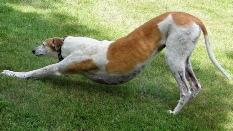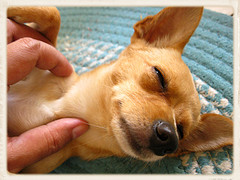Daily Doga © All Rights Reserved - Terms of Use

Wagasana, greeting the day
with gratefulness and curiosity!
Have you had a doga moment today?

Enlightened!
Awareness Centered Training - ACT
What is Doga Training (DT)? Doga is adjunct of Awareness Centered Training - ACT by Maureen Ross, MA
Dogs make us better humans. Let’s help make them better dogs with kindness.
Sitting still with your dog is training. It is teaching them to relax. We need more of that!
How we teach our dogs is a choice. ACT training, while living and learning with dogs, is joyful, easy and integrated. It is getting to know your dog while getting to know yourself. It is integrated on a daily basis and with clients at Dog Talk LLC. All dogs need training, and not just for 6-8 weeks in a class. Learning is on a continuum for health and well-being, at all stages of our lives.
While in the process of teaching, enjoy the benefits of gently desensitizing your puppies / dogs for real world activity. At home make teaching enjoyable and easy by integrating teaching into daily living and learning with our dogs using life rewards.
We all want to create a harmonious living environment for ourselves, our family and pets. Is that the reality? No, but we can strive for this shift by challenging ourselves to change. DT takes our training with dogs to a more perceptive level increasing awareness, learning and well-being. When change happens, we have the coping skills to survive. Puppies and adolescent dogs need to learn self-control - that’s happens with teaching basic manners and socialization.
Dogs are instinctual and we are intuitive. What a great combination of strengths. When we connect to, teach and learn from another species, it creates a positive trickling effect that flows through our lives (family, friends, careers, goals). This is like learning a new job or language, it forces us to learn a new way of communicating with a different species.
With numerous techniques and tools available for training, all of which I've passionately tried, the most effective, successful and pleasurable is integrating a win-win approach that is flexible and works best for your and your dog’s lifestyle (health, well-being, nutrition, exercise and stress management). Noticing when we are unbalanced and when to back-off or move-forward, comes from experience and observing the response we get from our dog. If they are not getting it, we are not teaching it in an understandable way. Are they well? Are you? Are they stressed? How about you?
Is it perfect or magic? No, life changes and challenges us daily. Barking, jumping, chewing, lunging, fear, shyness, learned aggression, resource guarding, or any undesirable, and natural behavior for a dog, can be shaped, re-shaped and managed with commitment and practice.
Sensory Overload
If the behavior is one that the dog needs to relieve stress (sniffing, barking, activity, sleep) then we need to create channels / space for them to redirect and release energy in a constructive way. These behaviors can be amplified or toned down depending on the volume of life. Dogs need to be dogs and have a job akin to their nature. By nature, they are crepuscular, meaning most energetic at dawn and dusk. They take on our circadian rhythms, accustoming themselves to our routines (habituating). Imagine! They take on our stress, so if we are combusting, they will too.
The natural instinct of the dog (breed, mix, nature, nurture, environment) is as obvious as their olfactory (sniffing in techni-color): They must be allowed to bark, dig, jump, exercise and be a dog. This usually is not the problem. The problem happens when the dog is being allowed to do this repetitively and reinforced for it (touching, laughing, smiling), and not taught what to do in a way that creates a lasting cellular connection / learning experience.
Doga is Awareness Centered Training - ACT. It’s pro-active training (teaching) rather than reactive training (responding after the behavior--usually to late to make a difference). Blending stress management, desensitization, healthy nutrition, exercise, fun and the necessary things that make living with dogs easier for us humans (sit, down, stay, come, back-up, easy, take-it, leave-it, wait, quiet) is part of training. Timing, intensity and getting to know what motivates (life rewards) your dog increases the likelihood of long-term success.
DT can help reduce stress in the same way a good workout can. Before exercise we warm-up, then increase intensity, and cool down with stretching. This increases flexibility, strength and balance, and helps to avoid injury. When we launch a new project, we gather information, organize, plan and implement it, knowing that we will need to make changes or choose a different path. Teaching our dogs requires the same approach.
Stress is part of life. We choose to add dogs to our lives because they make us feel good! Changes can be stressful for dogs too. Parachuting into a foreign country is a challenge, especially if we don't understand the culture or language. Dogs have a different language when they willingly join our domain. Our stressful lives transfer to our dogs, so if we take a moment, even while feeding our dogs to connect with eye-contact, ask for a sit and smile, that begins a relationship transition with you as benevolent leader and provider. Read Doggy Diner by Maureen Ross.
Teaching becomes a team learning experience, rather than me ALPHA, you dog. If we are stressed out, we may as well take a nap rather than train. Sitting still with your dog is training-- it is teaching a dog to relax.
Whether clicker training or using other forms of positive reinforcement to teach a behavior, training your dog can change your life, if you are consciously present. Metaphor: A tornado can cause tremendous damage, but not if you are in the eye. Being aware of the chaos swirling around you and your dog, without losing focus of what you are teaching, is empowering. In meditation or sitting quietly sipping tea-- the world outside (sounds, sights, smells) doesn't cease to exist. Even in a remote island sanctuary there will be noise. You can create an imaginary shield (bubble) around you, letting the rest float by. Witnessing “ourselves” while training, not just our dogs, enhances the learning experience.
An amazing feeling of accomplishment happens when we connect to another species. Dogs are not humans, although they play the part well. They have the ability to sense whether we are genuine or not. Just telling / forcing them to do something will make it happen, but to create a respected relationship, with compassion and understanding, is more fulfilling and long lasting.
Dogs fill our needs for companionship, love and working (seeing, hearing, rescuing, therapy). They listen to us, pretending to hear, and offer love, although it does have conditions, as a species. We need to care for, protect and teach them. Doing this makes us better human beings, and human beings are animals. Oftentimes, I think we forget this. We place ourselves in some exalted platform, stifling all opportunity to discover a new way of being. Dogs help us to appreciate enjoying the simple things in life that are precious (roll in the mud, hop in the hay, dance in the rain).
Embrace training dogs as a joyful part of daily living. Whether you choose to call it doga, A.C.T. positive, clicker, cluck-cluck, tssst, or your own creative name, honor it, if it works for you and your dog!
Learning does not start and stop with age, illness, change or species. Dogs can be a challenge and they can help us to overcome life's challenges. Training our dogs can change our lives.
Explore how integrating canine massage and other holistic approaches can enhance training ...


Canine Massage
Canine Stretch
Acupressure
TTouch
Nutrition
Reiki
Touching or touched? Everyone can enjoy it!
| About Doga |
| Meditations A-B |
| Meditations C-D |
| Meditations E-F |
| Meditations G-H |
| Meditations I-L |
| Meditations M-P |
| Meditations Q-T |
| Meditations U-Z |
| Authority |
| Amazement |
| Amazement |
| Awareness |
| Authentic |
| Balance |
| Barrier |
| Boundaries |
| Beauty |
| Bills |
| Breathing |
| Business |
| ElderYears |
| Energy |
| Empowerment |
| Enlightment |
| Enough |
| Expectations |
| Expanding |
| Fear |
| Family |
| Feelings |
| Finances |
| Freedom |
| Fouragreements |
| Forgiveness |
| Food |
| Gosspi |
| GivingReceiving |
| Graceful |
| Grateful |
| Growing |
| Greiving |
| Guilt |
| Happiness |
| Healing |
| Humor |
| Holidays |
| Immune |
| Individualility |
| Intuition |
| Joy |
| leadership |
| liferewards |
| LivingLearning |
| lihalligo |
| Love |
| Loss |
| Mindfulness |
| mine |
| Mirroring |
| NewBeginnings |
| Nutrition |
| OldTapes |
| Organization |
| Patience |
| Perfection |
| Peace |
| Purpose |
| Power |
| PlanetEarth |
| PerfectOrder |
| ProblemSolving |
| Prosperity |
| Relationshps |
| Releasing |
| Resentment |
| Sanctuary |
| SafeSex |
| Responsibility |
| Resilience |
| scanandswitch |
| SelfTalk |
| SelfLove |
| Spirituality |
| sit |
| stay |
| Thoughts |
| Support |
| Success |
| Truth |
| Transition |
| Time |
| Trust |
| vision |
| universe |
| uniqueness |
| understanding |
| unconditional |
| wisdom |
| wait |
| DDPrintable |
| DDcollections |
| Articles-Books |
| Canine Massage |
| Canine Stretch |
| Acupressure |
| TTouch |
| Reiki |
| Nutrition |